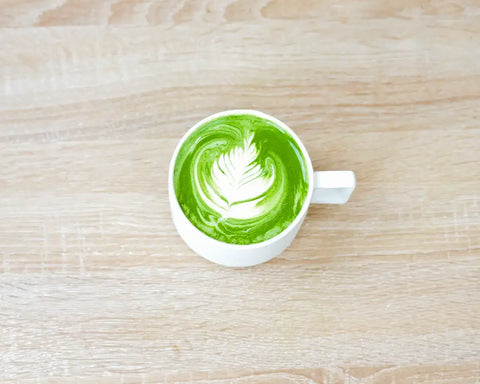What does matcha taste like?
Savoury and umami with a fresh and earthy flavour, the latter coming from the amino acid l-theanine.
The best way to learn how you like your matcha powder and discover what works best for you is to think of it like coffee. What I mean is that just like with coffee, you can adapt it to your tastes as it is incredibly versatile.
Can the Quality of Matcha Really Impact Its Flavour?
The short answer is yes, hugely. Imagine a fresh strawberry in summer vs. the pale ones grown out of season—incomparable.
The cultivation of the tea plant and the processing of the leaves is vital to achieving a balanced and authentic green tea. We have opted to source our matcha powder from Uji, Japan. The region is renowned for growing matcha, producing a powder with a naturally sweet flavour profile.
The best matcha will only come from the top of the camellia sinensis plant. The reason is that the bud and the top leaves and the most tender, providing the perfect texture as well as flavour. The plant should be covered so that as much chlorophyll as possible is produced - this is how we get those matcha benefits.
Once picked, the leaves need to be heated to stop them from fermenting - otherwise, you end up with a builder's tea! Next up, leaves become powder. Stone-grinding is the best method, it produces the least friction, which is important because you risk burning the tea, turning it bitter.
You can read more about the impacts of poor-quality matchas here. By and large, bad matcha can be seen immediately: the powder will be a dull green-brown, and it will taste unappealing. The second you open your pouch or tin you should immediately smell the freshness and see a beautiful verdant green powder. A poor quality tea will taste just like it looks: dull at best, but bitter and far too earthy at its worst.
Another key factor is preparation.
Matcha is a tea, but treat it like coffee. To start your preparation, follow these steps:
Combine 60ml of 80 degree water to 3g of sifted matcha powder. Do not use boiling water, as it will burn the powder, giving you a bitter tea.
Why does Matcha tea powder taste a little bit bitter?
If at any point during processing or preparing the leaves have been over-heated. Too much heat will cause any green tea to burn and become bitter. A poor quality matcha may be a combination of younger leaves, which are good, and older leaves and stem, which have an earthier taste.
Matcha can also taste bitter when it is mixed with other powder to bulk it out. The best way to avoid this is by checking the label - you want 100% matcha powder. If you're shopping flavoured matcha - then it is ok for there to be multiple ingredients.
Sourcing tea from the wrong place can also leave a bitter taste in your mouth. Japanese regulations enforce strict standards to ensure producers create the best quality products. Buying from other parts of the world is a risk as they may not have the same standards.
Does matcha tea need sweetener?
This completely depends on your taste! Below I have listed some recipe inspo - have a read through and pick which one you think you'll get along with. My recommendation would be to start with an iced matcha latte and add a sweetener if you need it. Definitely give it a go without first!
As your palette acclimates to the classic green tea flavour you will finding yourself increasing the strength.
Why is Matcha Different Colours?
The colour of the matcha tells you the freshness and the quality of the powder. A bright green powder is a sign that your matcha is high quality and fresh. A dull brown colour indicates that it has been mixed with other ingredients or that it has become stale.
Much like a fresh fruit or vegetable, matcha powder reacts to exposure to light and air in the same way. You should always keep your matcha tightly sealed and in the fridge to maximise freshness.
Whilst colour is important, smell is equally a great indicator or freshness and quality. You're looking for a fresh smell and with a lightly toasted aroma.
Next up, let's give you some inspiration now that you're up to speed!
Koicha -The Espresso
Mixing hot water with powder give you your espresso. Traditionally known as Koicha - this is the strongest way to enjoy matcha.
Traditionally, people enjoy this with a sweet Japanese treat called Wagashi, which is made from mochi. It balances the flavour nicely, but a cookie works just as well! If you're trying Koicha for the first time it is worth investing in a high grade matcha to ensure a delicious flavour and consistency.
The Tea
So you will likely have guessed how to make this one! Sift your powder (2-5g) with 200ml of hot water until you get a thin consistency. This tastes like a green tea with oomph. Again, it's important to use a good quality matcha here, no culinary or premium grade.
The Latte
Matcha powder combined with milk is your latte, and is great for beginners. Just like a coffee-based latte you can add syrups, spices, and your favourite milk. For syrups, we'd recommend Monin. Vanilla pairs especially well because it balances the heavier savoury flavour of matcha.
Once you've mastered the basics, you can start experimenting with different flavours and textures. For a refreshing twist, try adding a splash of coconut milk or almond milk to your matcha latte. These alternatives not only enhance the creaminess but also bring their own unique flavours to the mix. I'd recommend a combination of oat and almond milk for a great texture and flavour.
If you're feeling adventurous, consider incorporating spices like cinnamon or nutmeg, or even salt. A sprinkle of these can elevate your drink, adding warmth and depth. You might also enjoy sweetness from honey or maple syrup, which can complement the earthiness of the matcha beautifully.
For those who prefer a chilled beverage, iced matcha lattes are a fantastic option. Simply whisk your matcha powder with a small amount of hot water to dissolve it, then pour it over ice and top it with your choice of milk. This creates a refreshing drink that's perfect for warm days.
Don’t forget about the presentation! A beautifully crafted matcha latte can be so satisfying as well. Consider using a milk-frother or whisk to create a thick foam on top
As you explore the world of matcha, remember that the key is to enjoy the process. Each cup can be a new experience, so take your time to find the flavours and combinations that you love the most. Happy sipping!
The Hot Chocolate
Matcha also goes well with white chocolate, so we'd recommend adding about 40-60g of chopped white chocolate to 250g of hot milk. Whisk that up using the best whisk, and then add a shot of matcha espresso
The Real Green Goddess Smoothie
If you're keen to capitalise on the renowned benefits of this extra special green tea, look to the smoothie. I think this is the best and easiest way to integrate matcha into your life in a low maintenance way. It plays nicely with almost all fruits, especially blueberries and strawberries. Pop 1-5g of powder in, no sifting necessary and blend.




